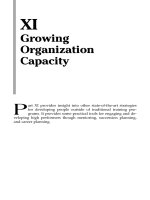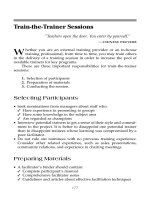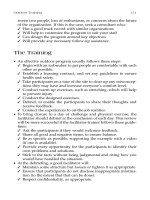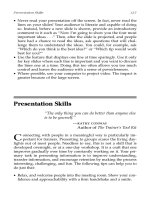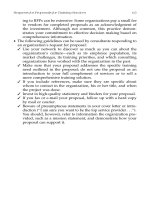The Trainer’s Tool Kit Second Edition phần 3 doc
Bạn đang xem bản rút gọn của tài liệu. Xem và tải ngay bản đầy đủ của tài liệu tại đây (342.03 KB, 18 trang )
45Budgets: Building a Case for More Training Dollars
Budgets: Building a Case for More
Training Dollars
M
ost organizations today find themselves in a catch-22 situation
about training. There is an increased need for training to pro-
vide help for employees challenged to meet changing market condi-
tions. At the same time, there are limited funds because of budget
restrictions.
Making a case for more training dollars requires research and
data from many sources. A comprehensive analysis about the re-
quirement for more training dollars should focus on the following:
• Business-plan liabilities
• Benchmarking
• Customer and employee feedback
Business-Plan Liabilities
• Your organization’s twelve-month business plan should outline key
initiatives that are critical to its success. Many of these initiatives
assume the availability of competent and trained staff. The business
plan can be jeopardized if staff is not trained in areas such as:
✓ New equipment startup
✓ New or enhanced information technology
✓ Maintenance and repair of older equipment
✓ Features and benefits of new products
✓ Updated research about customer attitudes and expectations
✓ New legislation affecting manufacturing processes, safety stan-
dards, workplace conditions, and employee relations
• Prepare a situation analysis that describes the current operating
capability for meeting these new requirements. Any skills shortfall
that is not in the training plan should be highlighted, costed, and
presented to management as a key condition for meeting planning
projections.
• In any operating environment, there are other liabilities attached to
PAGE 45
10916$ $CH3 10-21-04 08:00:26 PS
46 Maximizing the Training Investment
limiting training. These risks are often not seen as training issues—
until it is too late. Be on the lookout for the following signals:
✓ Unusually high staff turnover, often caused by inexperienced or
untrained managers
✓ Delays in meeting customer delivery deadlines
✓ Customer complaints about product defects and not meeting
service standards
✓ Equipment breakdown
✓ Billing mistakes and invoicing errors
✓ Missed production targets
• Training is not the solution for all these problems, but there may
be a relationship between training and performance standards in
past records. In documenting these relationships, compare the
costs of inefficiencies to the costs of training, and set priorities for
using training dollars where the benefits clearly outweigh the costs.
• Be sure to include an analysis of the availability of qualified,
trained staff to replace employees who leave. External recruiting
and on-site orientation are expensive.
Benchmarking
• Draw on the many sources of information that can help you to
determine a reasonable training investment for your organization.
Gathering this information should be an ongoing activity. The fol-
lowing sources can be accessed readily:
✓ Professional training associations that provide data about train-
ing costs, broken down by organization size and type.
✓ Government agencies that collect data about industrywide train-
ing expenditures (such as training costs or training days).
✓ Industry and trade associations, which often conduct surveys to
benchmark training costs.
✓ Your own organization. With a little research, you can analyze
annual changes to the training budget and compare them with
changes in employee population and business-plan achieve-
ment.
✓ Consultants who work with your organization often have inter-
esting observations about overall trends for training invest-
ments.
• When presenting your research, be sure to include all associated
costs of training, including the following:
PAGE 46
10916$ $CH3 10-21-04 08:00:27 PS
47Costs and Benefits of Training
✓ Training-staff salaries
✓ Multimedia equipment
✓ Outsourcing
✓ Reference materials
✓ Travel and accommodation costs
• Break down all associated costs, and pinpoint which ones can con-
tribute to greater efficiencies and economies of scale.
Customer and Employee Feedback
• Customer and employee feedback can provide compelling evi-
dence for the need for increased training investments. Use the fol-
lowing tools to gather meaningful feedback and ongoing needs
analyses:
✓ Employee attitude surveys
✓ Information about training practices and needs gained during
exit interviews
✓ Records to help you track the number of employees hired exter-
nally over a period of time due to a lack of qualified internal
candidates
✓ Employee focus groups
✓ Customer focus groups
✓ Customer complaint logs
✓ Customer satisfaction surveys
✓ Feedback from sales and customer service representatives
Costs and Benefits of Training
‘‘Only the educated are free.’’
—epictetus
Roman Philosopher, Slave, and
Author of Discourses
M
ost organizations would like to be able to measure the costs
invested in training initiatives against anticipated results. The
challenge is that it is far easier to measure the costs of conducting
PAGE 47
10916$ $CH3 10-21-04 08:00:27 PS
48 Maximizing the Training Investment
training than it is to quantify results. A useful tool in determining
costs and savings is to compare costs per participant versus savings
per participant.
Comparing costs and benefits can be done in the following four
simple steps:
1. Calculate the cost of training. This will include training costs
such as:
✓ Facilitator fees
✓ Training design
✓ Course materials
✓ Videos and workbooks
✓ Facilities rental
✓ Equipment rentals (such as overhead projectors)
✓ Production downtime (including employee time off the
job)
✓ Videoconferencing facilities
✓ Specialized computer equipment
✓ Administration (such as registration procedures or con-
firmation notices)
✓ All the relevant costs, divided by the anticipated number
of participants, gives the cost per participant.
2. Determine the potential savings generated. These savings
might include:
✓ Fewer errors
✓ Reduced customer turnover
✓ Less equipment downtime
✓ Increased revenue collection
✓ Faster equipment start-up time
✓ Reduced employee turnover, when turnover is attributable
to poor supervision
✓ Proper implementation of new customer strategies
✓ Higher workplace morale through more effective manage-
ment practices
✓ Less time lost to grievance hearings and work stoppages
because of ineffective supervision
✓ Reduced recruitment costs (because training can create
more job-ready candidates for promotions)
✓ Maximized productivity of new employees through effi-
cient orientation training
PAGE 48
10916$ $CH3 10-21-04 08:00:27 PS
49Costs and Benefits of Training
3. Calculate the potential savings. To calculate potential sav-
ings, set goals for post-training achievements by identifying
and quantifying the changes a training initiative will produce
if all other factors are constant. The factors in the formula in-
clude the following:
✓ Current level of performance (for example, 200 error rates
per month; 6 lost customer accounts per month; 5 days lost
to work stoppages per year).
✓ Translate the current level of performance into a dollar
figure. For example:
200 error rates ן 5 minutes correction time ן $15 salary per hour ס
$250 per month
✓ Identify the change that training can produce (for example,
reduce errors to 50 per month
✓ Calculate the savings that the target criteria will generate.
For example:
200 errors מ 50 errors ס decrease of 150 errors per month savings ס
150 ן 5 minutes/60 ן $15 ס $187.50
✓ Identify a meaningful time line for realizing savings, based
on your best business predictions about factors contribut-
ing to errors remaining unchanged.
✓ Identify the number of employees in the target training
group.
✓ Divide the total anticipated savings by the number of parti-
cipants to identify the savings per participant.
4. Compare the costs to savings.
✓ Multiply the cost per participant by the total number of
participants.
✓ Multiply the savings per participant by the total number of
participants.
✓ Compare your figures to establish your business case for
training.
This exercise not only identifies actual costs and realistic savings
but also ensures that your training expectations are reasonable and
targeted to measurable business outcomes.
PAGE 49
10916$ $CH3 10-21-04 08:00:28 PS
50 Maximizing the Training Investment
Alternatives to Training
O
rganizations want to find the fastest, most realistic way of clos-
ing a knowledge or skill gap. Do an upfront needs analysis to
make sure that training is the answer.
• Training cannot close a skill gap that is caused by:
✓ Poor morale or attitude
✓ Poor policies or procedures
✓ Equipment problems
✓ Lack of incentives
• Training may not be the fastest solution for closing a skill gap
when:
✓ The time to develop and deliver the training cannot meet new
skill implementation deadlines.
✓ Employee time off the job to attend training will result in de-
creased productivity.
✓ Work shifts and holiday schedules necessitate training small
groups at one time, over a long period of time.
• Training may not be the most realistic solution for closing a skill
gap when:
✓ There are only a few employees affected by a new skill require-
ment.
✓ The need for new skills is only short term.
✓ Costs of a course are higher than the benefits the training will
produce.
✓ Regular training courses are poorly attended.
✓ Courses convey information only, not skill building.
• The following alternatives to training can close skill gaps:
✓ Change hiring and promotion criteria to reflect new skill re-
quirements.
✓ Pay higher salaries for some positions to attract job-ready em-
ployees.
✓ Institute job-shadowing programs.
✓ Set up formal mentor programs.
✓ Implement job rotations for hands-on practical experience.
✓ Set up buddy systems with retired employees.
PAGE 50
10916$ $CH3 10-21-04 08:00:28 PS
51Alternatives to Training
✓ Recognize and reward managers who are effective coaches.
✓ Set up individual development plans for employees whose per-
formance is unsatisfactory.
✓ Create self-service employee learning resource centers, which
provide training materials that people can borrow.
✓ Develop user-friendly, self-paced, how-to manuals and job aids
for common problems.
✓ Establish help lines for equipment- and technology-related
problems.
✓ Designate experienced employees as troubleshooters for special-
ized problems.
✓ Put together a list of employees with specialized skills and train-
ing who can provide individual assistance.
✓ Hold cross-functional meetings for employees to share their ex-
pertise.
✓ Set aside time in regular meetings for employees to brainstorm
problems and coping techniques.
✓ Invite industry experts to participate in information panels.
✓ Design a tuition reimbursement program for job-related educa-
tion.
✓ Reimburse employee purchases of job-related books and videos.
• Training is especially ineffective and expensive when it is used:
✓ To train large groups of people in order to correct the behavior
of only a few.
✓ To inspire or motivate employees. Only good management prac-
tices and meaningful compensation strategies can do that.
✓ To correct fundamental hiring errors.
✓ To encourage employees to market or sell products that the cus-
tomers don’t want.
✓ To solve disciplinary problems. These are one-on-one situations.
✓ To reduce employee turnover or absenteeism. Working condi-
tions are usually the culprit here.
• Employee input and feedback are often the best source of sugges-
tions for cost-effective alternatives to expensive training. Put their
resourcefulness to work for you.
PAGE 51
10916$ $CH3 10-21-04 08:00:28 PS
52 Maximizing the Training Investment
Stretching the Training Dollars
A
training course that has high-priority impact shouldn’t be aban-
doned because of an apparent high cost. The following mea-
sures can reduce total costs so that key training interventions aren’t
shelved:
• Train key participants, and use them as coaches for others.
• Break down course material into modules to reduce the strain on
daily operations.
• Reduce lengthy courses to key teaching points, and supplement
them with videos and books.
• Set up partnerships with other organizations to share the costs of
common training courses.
• Seek out government grants or industry association support for
costs.
• Split the costs of training with participants for personal develop-
ment courses.
• Negotiate with consultants for approval to reproduce training
manuals in-house.
• Negotiate volume discounts with consultants.
• Conduct training after hours or on weekends.
• Apply penalties to no-show scheduled trainees where costs are in-
curred to run the program.
• Use in-house subject matter experts as facilitators.
• Share costs with unions or other employee associations.
• Explore lower-cost training provided through local colleges and
universities.
• Conduct training on site rather than at expensive hotels or confer-
ence facilities.
• Trade training sites with local organizations.
• Set up volume discounts with airlines and hotels to reduce travel
expenses.
• Arrange lower consultant costs in exchange for free publicity.
• Co-venture a new training program with a vendor. You get unlim-
ited access; the vendor gets the copyright.
PAGE 52
10916$ $CH3 10-21-04 08:00:29 PS
53Using Consultants
• Put together a group of organizations with similar needs for vol-
ume discounts or to fund all-new design.
• Travel costs for trainees and facilitators can be significant. They can
even lead to delays or cancellation of important training projects.
Use the following tips for reducing these costs:
✓ Videotape important sessions so that employees who cannot at-
tend scheduled courses can understand the key teaching points.
This is more cost-effective than makeup sessions.
✓ Set realistic limits for meals and incidental expenses during
travel.
✓ Start training courses at noon so that out-of-town employees can
save the cost of a hotel room the night before the session.
✓ For some training courses, videoconferencing can be a cost-
effective alternative. If your organization does not have its own
facilities, explore the possibility of renting facilities at a local
college or university.
✓ Provide incentives (such as dinner coupons or theater tickets)
for employees to stay with friends or relatives during training at
an out-of-town location.
Using Consultants
‘‘Competence, like truth, beauty and contact lenses,
is in the eye of the beholder.’’
—laurence j. peter
Canadian Teacher and Author of The Peter Principle
F
or every consulting success story, there’s a story about poor ser-
vice, outrageous prices, and dashed expectations. The availabil-
ity of consulting firms and independent entrepreneurs presents
greater choices than ever before. At the same time, checking credibil-
ity can be a challenge, yet no organization can afford poor service.
• Consultants provide several advantages:
✓ Up-to-date training expertise in specialized areas
PAGE 53
10916$ $CH3 10-21-04 08:00:29 PS
54 Maximizing the Training Investment
✓ Lower-cost solutions for repeated training needs or for one-
time-only initiatives
✓ Different perspectives
✓ Labor-market information gained from working with other or-
ganizations
✓ Responsiveness to meet tight deadlines
✓ Skills and programs that are not available in-house
• Some disadvantages in dealing with consultants are that they:
✓ Have less commitment to an organization’s long-term success
✓ Cost more, on an hourly basis, than internal training staff
✓ Work for your competitors too and may jeopardize confidenti-
ality
✓ May not have an in-depth appreciation of your organization’s
culture
✓ Will want to be paid no matter how successful (or unsuccessful)
the initiative is
• Managers are bombarded with calls from consultants offering their
services. Use the following suggestions for managing a high vol-
ume of unsolicited calls:
✓ Never be rude. You represent your organization at all times, and
any bad manners on your part reflect on your organization.
✓ Request literature from consultants before agreeing to a meet-
ing. This material will give you a sense of the professionalism of
the consultant and client references.
✓ Designate one afternoon a month to meet with prospective con-
sultants.
✓ Mail out copies of your organization’s training catalog to callers.
This will save time on both sides so that consultants don’t pitch
for programs that you already have.
✓ Prepare a semiannual summary of your training needs to send
to callers so that you will hear back only from those who are
able to meet your requirements.
✓ Designate a junior training employee to meet with callers to
screen those who may meet your needs.
✓ Ask callers about their industry expertise, client references, and
training credentials.
✓ Ask callers about their perspective on training trends and orga-
nization challenges to gain a sense of their experience.
✓ Meet with some consultants from time to time. They bring infor-
mation about the marketplace.
PAGE 54
10916$ $CH3 10-21-04 08:00:29 PS
55Using Consultants
✓ Keep all literature you receive from consultants during the year.
This is an excellent source of competitive information and re-
search.
• Before hiring a consultant, ask the following questions:
✓ How good is the consultant’s reputation? You don’t judge a
book by the cover, so don’t base your evaluation on the slickness
of the consultant’s brochures or presentation.
✓ How did the consultant contact you? Was it a reference or a cold
call?
✓ What makes the consultant uniquely qualified to help you with
the particular challenge you have?
✓ How credible are the consultant’s references?
✓ How similar have the consultant’s other assignments been to
your own, and how effective has the training been?
• During an interview meeting with a consultant, establish:
✓ What makes his service special? What innovative work has the
consultant done?
✓ Whether the consultant is using your organization as a test site
for a new program.
✓ What written materials will be made available to the trainees?
Will they be customized?
✓ How flexible the consultant is about specific issues you have
about costs, numbers of trainees, and the time of training (eve-
nings, weekends, etc.).
✓ Whether the consultant will provide you with a written outline
of the program, including course objectives.
✓ How the effectiveness of the training will be measured.
✓ If any guarantees about improvement are given in measurable
formats.
✓ The professional qualifications and experience of the trainer
who will be working on your assignment.
✓ The personality and motivational style of the trainer. Given the
culture of your organization, will that style fit?
✓ How flexible the trainer is in terms of course duration and
course content. (Short, punchy modules over a period of time
are more effective than lengthy three-day workshops.)
✓ Whether your staff will have a direct hotline to the trainer when-
ever they need support or advice.
✓ What homework the consultant has done about your organiza-
PAGE 55
10916$ $CH3 10-21-04 08:00:30 PS
56 Maximizing the Training Investment
tion in terms of size, market niche, competitive edge, and prod-
uct lines.
✓ How competitive the fee structure is compared with others in
the field.
✓ Whether the quoted prices are inclusive, or whether there are
additional costs for duplication of materials, travel, and other
items.
✓ If and how often the consultant speaks at high-profile confer-
ences.
✓ Whether the consultant has published articles in respected jour-
nals or newspapers.
✓ Whether the consultant does work for any government. (Gov-
ernments are very strict in qualifying consultants.)
✓ If the trainer has backup in the event of sickness or other emer-
gency for a scheduled training course date.
✓ If the consultant belongs to any recognized professional associa-
tions.
✓ How long the consultant has been in business.
✓ Relevant experience in your industry.
• Despite your best efforts, there may be occasions that leave you
feeling that your money was spent poorly and time was wasted.
Examples of poor investments include:
✓ The majority of trainees considered the training a waste of time.
✓ You paid a premium price for a poor product.
✓ The consultant’s conduct was unprofessional and resulted in
complaints.
✓ Promised workbooks and videos for the session were not avail-
able.
• Here are some follow-up techniques that can minimize the impact
of a consultant’s poor performance:
✓ Negotiate for a reduced fee for the work already done.
✓ Negotiate for reduced fees for upcoming initiatives.
✓ Ask the consultant to prepare a recovery strategy at no extra
cost.
✓ Ask the consultant to stage a free ‘‘lunch-and-learn’’ seminar.
✓ Review trainee evaluations with the consultant as a mutual
learning opportunity.
✓ Apologize to trainees for any inappropriate or insensitive re-
marks the consultant made. Make it clear that this is not the
organization’s way of doing things!
PAGE 56
10916$ $CH3 10-21-04 08:00:30 PS
57Outsourcing
✓ If you generally like the services of the consulting firm and are
disappointed with one specific representative, ask for a replace-
ment for the rest of the project.
✓ Explain your follow-up strategies to disappointed trainees.
✓ Do research and trainee follow-up to determine whether you are
reacting to the opinions expressed by only a few malcontents.
✓ For long-term projects, pay a penalty fee to discontinue the ini-
tiative rather than hoping for the best if initial reviews are poor.
✓ Use every poor consulting experience as an opportunity to un-
derstand your role in setting realistic expectations.
• Consultants have rights too. It is difficult for them to be successful
when organizations don’t deliver the information or access to back-
ground material that was promised. Changing delivery dates, can-
celing meetings, or delaying payments is unprofessional—and it is
behavior that you would never tolerate in a consultant.
Outsourcing
O
rganizations everywhere are focusing resources and energy on
managing their core businesses and are finding it more econom-
ical to outsource some activities to specialists who can demonstrate
quality, delivery, and cost competitiveness.
• Organizations outsource a variety of training activities, including
the following:
✓ Specialized course development
✓ Specialized course delivery
✓ Training needs analysis
✓ Training facilities
✓ Designing information systems that track training statistics
✓ Training administration
• Outsourcing some or all training activities should be considered if
any of the following conditions exist for your organization:
PAGE 57
10916$ $CH3 10-21-04 08:00:31 PS
58 Maximizing the Training Investment
✓ Demand for training fluctuates during the year and from year
to year.
✓ In-house expertise cannot meet some specialized training re-
quirements.
✓ A specific training need is a onetime-only occurrence.
✓ The ongoing costs of an in-house training department become
difficult to justify.
✓ There is a high rate of no-shows for your training courses, which
can imply that the curriculum is not relevant to the organiza-
tion’s challenges.
✓ Training-department staff members are often deployed to other
functions to meet operational needs.
✓ Your organization is spending significantly more than similar-
size organizations for the same amount of training.
• Outsourcing has a number of advantages, including:
✓ Reduced overhead costs
✓ A direct relationship between training needs and training costs
✓ Meaningful cost-benefit analysis applied to training require-
ments
✓ Focused expectations for results, based on expenditures
✓ A wider selection of qualified professionals to meet organization
needs
✓ The ability to terminate unproductive consulting relationships
✓ Better ability to use the latest methodology and training tech-
niques
✓ Greater competitiveness by using current information
✓ Accurate tracking of training costs
✓ Reduced administrative costs incurred in managing training
✓ Just-in-time delivery for important initiatives
• The disadvantages of outsourcing include the following:
✓ Typically higher costs for outsourcing on a project-by-project
basis
✓ The use of consultants who may not understand your business
plan
✓ The use of consultants who are not as committed to your corpo-
rate objectives as in-house training staff may be
✓ Confusion generated in your employee population by a multi-
plicity of messages and biases from consultants
✓ Reliance on consultants’ availability for scheduling delivery
dates
PAGE 58
10916$ $CH3 10-21-04 08:00:31 PS
59Choosing Facilities
✓ No on-site availability of internal training consultants for im-
promptu meetings about training requirements
✓ Time-consuming research about prospective consultants and
meetings and interviews with them
✓ Training initiatives that may not be linked easily to your organi-
zation’s recruitment, promotion, and career-development strate-
gies
✓ Potential breaches of confidentiality with respect to important
corporate strategies
• Each organization makes its own decisions about the cost-effective-
ness of outsourcing, depending on the availability and cost of inter-
nal training staff. When outsourcing does occur, the cost-benefit
analysis should be reviewed regularly in light of changing business
variables.
Choosing Facilities
C
lassroom training can be conducted on or away from an organi-
zation’s premises. The following guidelines can help you find
the best venue.
Making the Choice
The following list includes items that all good sites should have:
• Nearby restrooms
• A telephone number for messages for participants
• Message board
• Nearby breakout rooms
• Adequate coatracks
• Access to good equipment (flip charts, markers, wall space to put
flip charts, etc.)
PAGE 59
10916$ $CH3 10-21-04 08:00:32 PS
60 Maximizing the Training Investment
• Lighting controls
• Electrical outlets placed conveniently for equipment usage
• Coffee service table
• Trash containers
• Comfortable chairs and tables
• Public transportation access
• Adequate parking
• Handicap access
• Transportation arrangements to and from local airports
• Early-morning access
• Proximity to a variety of good eating places
Costs
Costs will vary depending on your needs. When you’ve decided
on a venue, ensure that there are no surprises by determining
whether the following costs are covered in the ‘‘package’’:
• The room
• Equipment rental
• Coffee and lunch service
• Breakout rooms
• Cancellation penalty
• Discounts for trainees who are staying overnight in the facility
• Volume discounts for frequent use
• Facilities
Alternative Facilities
Using hotels for off-site training can be expensive. Consider the
following lower-cost alternatives:
• Organization boardrooms and conference rooms
• Local educational institutions
• Boards-of-trade facilities
• Vendor training facilities
• Training rooms in other organizations
• Government facilities (for example, city hall)
PAGE 60
10916$ $CH3 10-21-04 08:00:32 PS
61Requests for Proposals for Training Services
• Industry association facilities
• Professional association facilities
• Public libraries
Urge your staff to be creative in suggesting training sites. For
example, consider holding workshops in different employee homes
when you have a smaller group. The host can be rewarded with a
floral arrangement and all food left over from the luncheon buffet.
The trainers enjoy a comfortable learning environment while enjoy-
ing the hospitality of a team member.
Requests for Proposals for Training
Services
M
any organizations use requests for proposal (RFPs) when con-
tracting training services. These are formal documents that set
out criteria and specifications for training projects. Organizations
may invite selected vendors to bid for the project or publicize the RFP
in an open forum, such as a trade journal.
• The advantages of using an RFP for training services are:
✓ Expectations for the project are clear.
✓ Proposals from vendors are in a consistent format.
✓ Comparing vendors against common criteria enhances decision
making.
• RFPs are most commonly used for the following reasons:
✓ The project is extensive in terms of size, budget, and impact.
✓ A organization’s administrative procedures stipulate that all
contracts over a set price must be put to bid.
✓ A number of people will be involved in the decision.
✓ The decision makers do not have in-depth knowledge of the
products and services available in the marketplace.
• It is difficult to choose among many competent vendors. However,
PAGE 61
10916$ $CH3 10-21-04 08:00:33 PS
62 Maximizing the Training Investment
it is in the organization’s best interest to be perceived as fair and
equitable in awarding contracts.
• RFPs can include as many criteria as deemed important. At a mini-
mum, all RFPs should include:
✓ A clear description of the project and anticipated outcomes
✓ The number of employees to be trained
✓ Deadline date for the receipt of a completed RFP
✓ Deadline date for the completion of the project
• State your expectations clearly in your RFP. You may even invite
vendors to make recommendations for criteria, which typically in-
clude:
✓ Pricing
✓ Deliverables, including workshop objectives
✓ Project evaluation criteria
✓ Meetings with the organization
✓ Materials (for example, workbooks and handouts)
✓ Invoicing and payment guidelines
• The following additional vendor information in the completed RFP
can help the decision-making process:
✓ Organization background
✓ Financial statements
✓ Facilitator profiles
✓ Client profiles and references
✓ Professional accreditation
✓ Sample materials, such as workbooks
• Sometimes special circumstances should be noted in the RFP, for
example:
✓ The need for training in a second language, such as French or
Spanish
✓ Potential conflicts of interest (some organizations require ven-
dors to declare any family relationships in the organization)
✓ A requirement for potential vendors to declare current or recent
contracts with competitors
• In choosing a format for your RFP, consider the following options:
✓ A standard form already used by your organization for award-
ing contracts.
✓ An adaptation of a form used by your organization.
✓ An adaptation of a form developed for training contracts used
by other organizations.
✓ The time, research, and energy that vendors invest in respond-
PAGE 62
10916$ $CH3 10-21-04 08:00:33 PS

